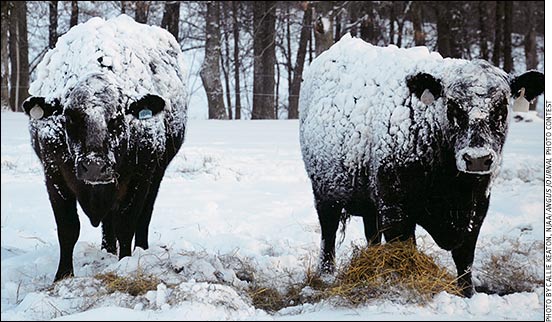HEALTH & NUTRITION...

Winter Cow Management
Pay attention to nutritional needs.
According to Shannon Williams, Lemhi County Extension Agent in Salmon, Idaho, the most important thing in winter cow management is to make sure you are meeting your cows’ nutritional requirements according to where they are in their gestational stage.
Dick Fredrickson, veterinarian and nutritionist for Simplot, Grandview, Idaho, says, “Assuming cows have adequate energy from forage, the next important thing is mineral supplementation — which is critical for digestion of forage.” Read more.
5 Tips for Winter Supplementation
Early cold stress can result in a snowball effect if left unchecked.
Now that the first blast of winter weather is quickly approaching, have you thought about what that means to your cows?
Cold temperatures significantly raise energy requirements. Undeveloped winter hair coats, wet hides and wind all combine to magnify this increase in energy requirements. The combination of calving cows and colder environmental conditions can easily result in producers not providing enough feed energy and cows losing weight.
So what can producers do to manage the cold stress and feed adequately during the winter months? Here are some tips. Read more.
Making the Most of Mineral in 2016
Maximize your mineral program by analyzing mineral needs, making sound product decisions and using best-management practices.
Cattle nutrient requirements can vary by season and stage of production — and now is a great time to evaluate your mineral program and map out a plan to maximize impact in the new year.
“Minerals are a relatively small portion of the diet, but they control many vital functions in cattle,” says Kent Tjardes, cattle consultant for Purina Animal Nutrition. “They impact everything from cattle reproductive and nervous systems, to feed efficiency and overall herd health. That’s why it’s so important to make sure the mineral needs of your cattle are being met year-round.” Read more.

Rick Rasby
Ridin’ Herd
Test for nitrates in summer annuals.
In most parts of the United States, we enjoyed a pretty nice fall with some moisture. There were opportunities to graze dormant winter range and corn residue. In many places, there is no opportunity to develop a beef cow-calf system where cows can graze year-round. Feeding harvested hays adds expense to the operation — not only because of the hay costs, but also the costs associated with feeding hay, such as equipment, labor and fuel. Producers may have bought or raised a summer annual this summer and fall and harvested it as a forage to feed this winter. Read more.
Prevent Calf Abnormalities by Managing Cow Diets
Feeding silage, baleage or apple pulp to pregnant beef cows requires careful management to avoid congenital defects.
Beef cow gestational nutrition may hold the key to a serious congenital defect of beef calves. Affected calves, called “acorn calves” or “bulldog calves,” are the result of a condition referred to as congenital joint laxity and dwarfism (CJLD), congenital spinal stenosis or congenital chondrodystrophy of unknown origin (CCUO). An association of CCUO with grazing drought-affected pastures, feeding silage-only diets, or supplementation with apple pulp strongly suggests a nutritional link. Read more.
Scrotal Frostbite in Bulls
Windbreaks and bedding protect bulls from scrotal frostbite.
Cold weather, especially with wind chill, can result in bull infertility the next breeding season. Fertility may be temporarily or permanently affected. George Perry, professor and extension beef reproduction specialist at South Dakota State University, says spermatogenesis — the generation of sperm — in a bull takes 61 days.
“Anything that affects sperm production will take 61 days to totally clear the system and have normal cells and healthy sperm after the bull recovers,” he explains.
If frostbite was severe, it may take several months before the bull is fully recovered.
“A few years ago we checked a bull that had frostbite in February, and by June he was fine. Where the sperm is in the production cycle can make a difference in what will happen to it when frostbite occurs,” says Perry. Read more.
How to Save Leftover Silage Inoculant
Tips for keeping excess silage inoculant alive and effective until next year’s harvest.
Now that this year’s silage crop has been harvested and stored, producers with leftover inoculant can safely store excess if they keep in mind a few simple guidelines, says Renato Schmidt, forage products specialist, Lallemand Animal Nutrition.
First, always keep the product refrigerated or frozen until use. Keeping the inoculant cool helps maintain the viability of the living organisms within the package, Schmidt says. Read more.
Cattle Diseases: Common Conditions/Terms
Click here for a list of common conditions and terms related to beef cattle diseases, such as anaplasmosis, brucellosis, BVD, E. coli, IBR and others.
[Click here to go to the top of the page.]





